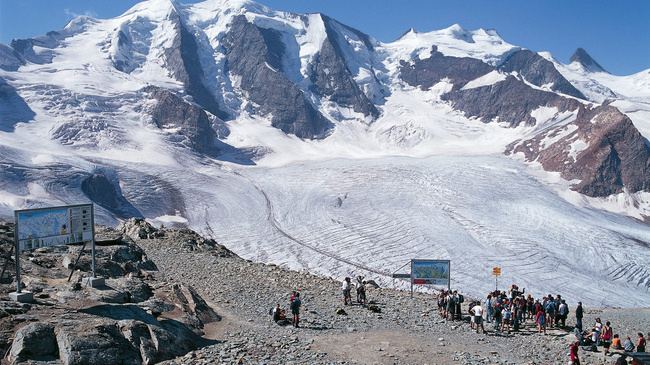Prominence 0 m (0 ft) Mountain range Rhaetian Alps | Translation female devil (Italian) Canton Grisons Elevation 2,978 m | |
 | ||
Similar Piz Corvatsch, Piz Bernina, Piz Lagalb, Muottas Muragl, Corviglia | ||
The Diavolezza is a mountain viewpoint above the Val Bernina in Graubünden. It has an altitude of 2,973 metres (9,754 ft) and is located between Munt Pers (northwest, 3,207 metres (10,522 ft)) and Piz Trovat (southeast, 3,146 metres (10,322 ft).
Contents
Map of Diavolezza, 7504 Pontresina, Switzerland
From Diavolezza you can see the highest peak of the Eastern Alps: the Piz Bernina and the Vadret Pers, a tributary of the Morteratsch Glacier (Vadret da Morteratsch).
The mountain can be reached by cable car from Val Bernina, the Bernina Pass valley. At the base station of the cable car on 2,093 metres (6,867 ft) there is train station Bernina Diavollezza on the Bernina Line of the Rhaetian Railway (RhB)). At the top station, there is a restaurant with a panoramic terrace, as well as a hotel offering both hotel-class and bunk-style accommodations.
The Diavolezza is one of the ski areas of the Upper Engadine (from 1'896 m to 3'066 m). The skiing area is connected to that of Piz Lagalb, which lies on the opposite side of the valley. The two areas are usually promoted as one, called Diavolezza-Lagalb. The Diavolezza-Lagalb area is known for its difficult slopes, all red and black, as well as the good snow conditions lasting often as long as May. Especially popular is the difficult 10 kilometres (6.2 mi) slope down the Morteratsch Glacier to the Morteratsch railway station (the slope on the glacier is marked and secured).
Each month at full moon, there is moonlight skiing in the evening.
The Legend
“La Diavolezza” – The beautiful she-devil
Once upon a time, many, many years ago, there lived on high a magnificent mountain fairy-queen. She lived in her mountain stronghold high up between Chapütschöl and Munt Pers, a place where, among towering crags and vast expanses of rocky scree, a deep-blue lake set among a flower-strewn mountain pasture mirrors the sunlight, where herds of sprightly chamois gambol around and graze on the lush green grass, where grouse and moorhen cluck and cackle, take flight and then elegantly glide to the ground to feed and cackle some more, where wide-eyed mountain hare daydream, then suddenly start and dash in a long-limbed gallop.
Hunters rarely spotted this magnificent she-spirit – and only ever fleetingly – but when they did, they gazed fondly as she moved across the rock faces of the Munt Pers to the Lej da la Diavolezza to bathe in its refreshing waters. With time the young huntsmen became quite besotted, and then indiscreet. They followed her, protected as she always was by her herd of chamois, across the rocky cliffs to her fortress of stone.
No-one really knows what happened then; one can only guess. One hunter after the other disappeared, erring forever on the Munt Pers (or lost mountain). Such was the fate of Aratsch, a handsome youth from the village, who never returned from the hunt. They searched for him high and low, yet in vain, and in the end forced to assume he had fallen into a glacier crevasse on Munt Pers or plummeted to his death. Indeed, anyone thereafter who at nightfall still lingered among Bernina Massif could hear the wailing voice of the Diavolezza borne on the drifting wind, calling: mort ais Aratsch (Aratsch is dead).
This story has been told from one generation to the next and, in time, the beautiful alpine meadow in the caldera of the Bernina group was named Alp Morteratsch.
But still the Diavolezza would not rest, not until the glacier had inched its way down and covered the entire mountain alp with ice and scree, right down to the valley. Only then did she finally leave the region, lamenting davent dal Munt dal Pers – and was never seen again.
